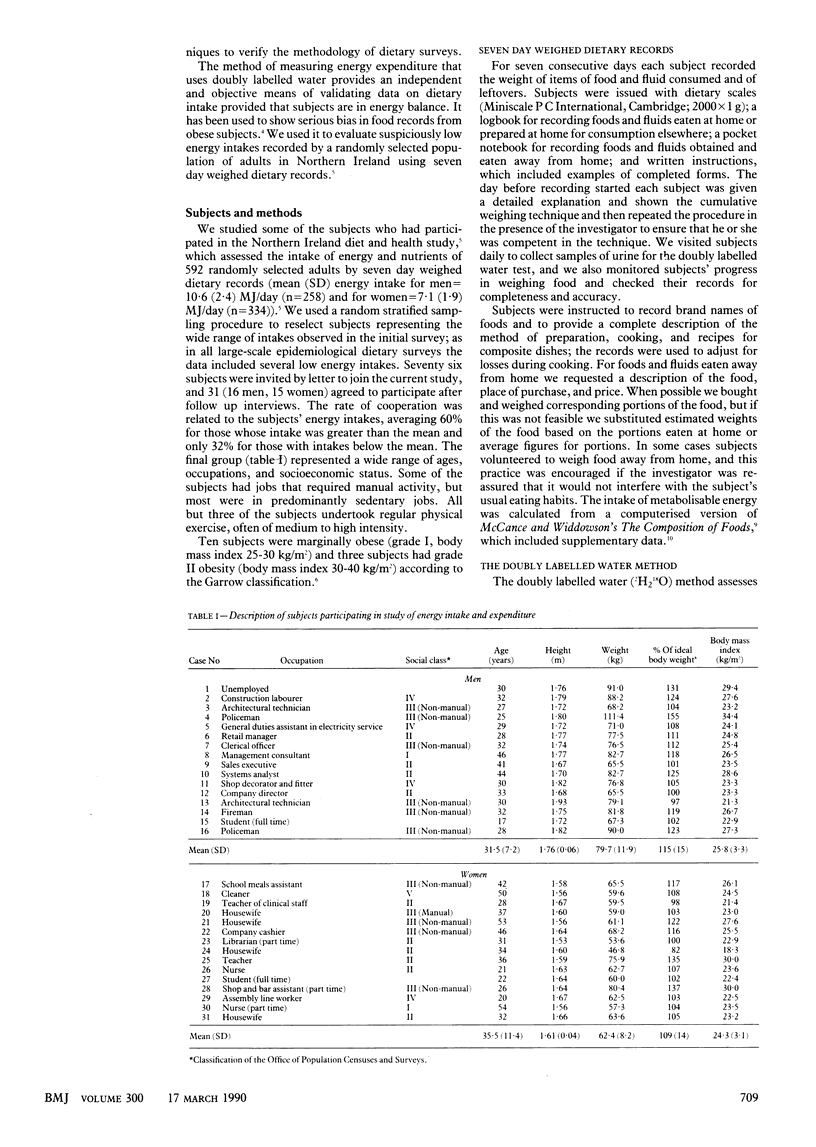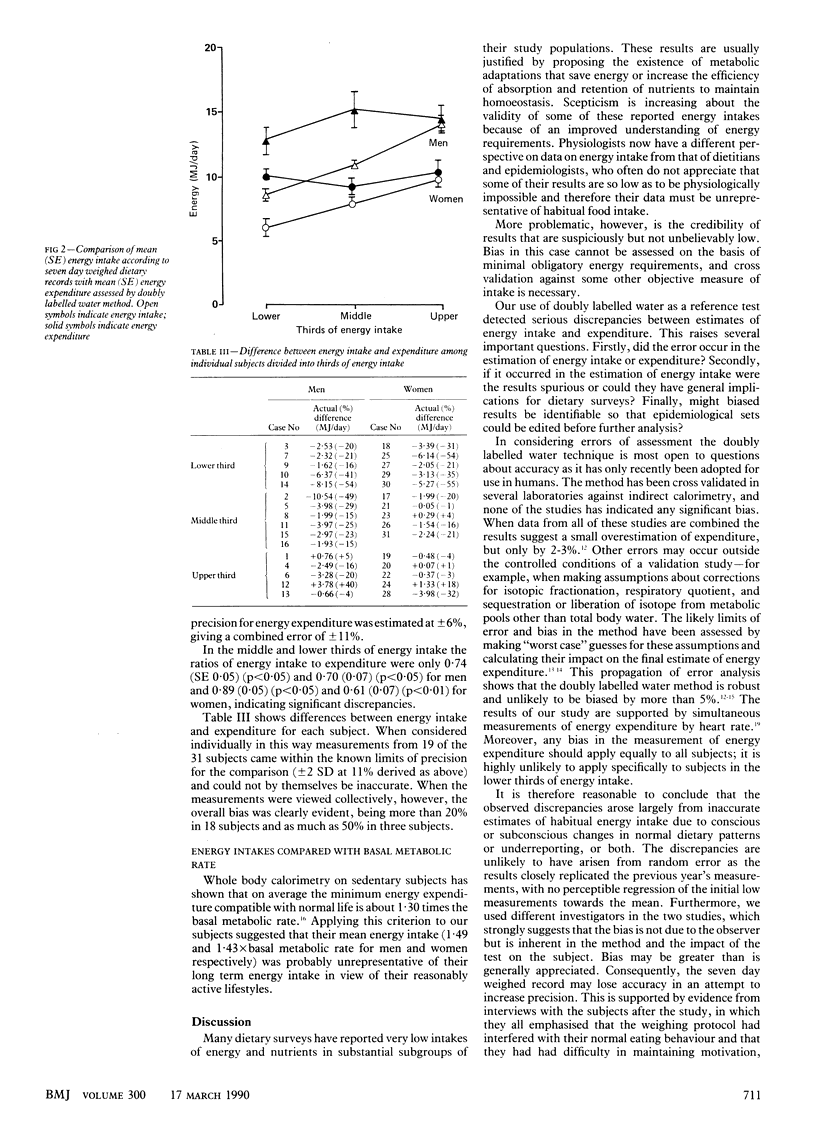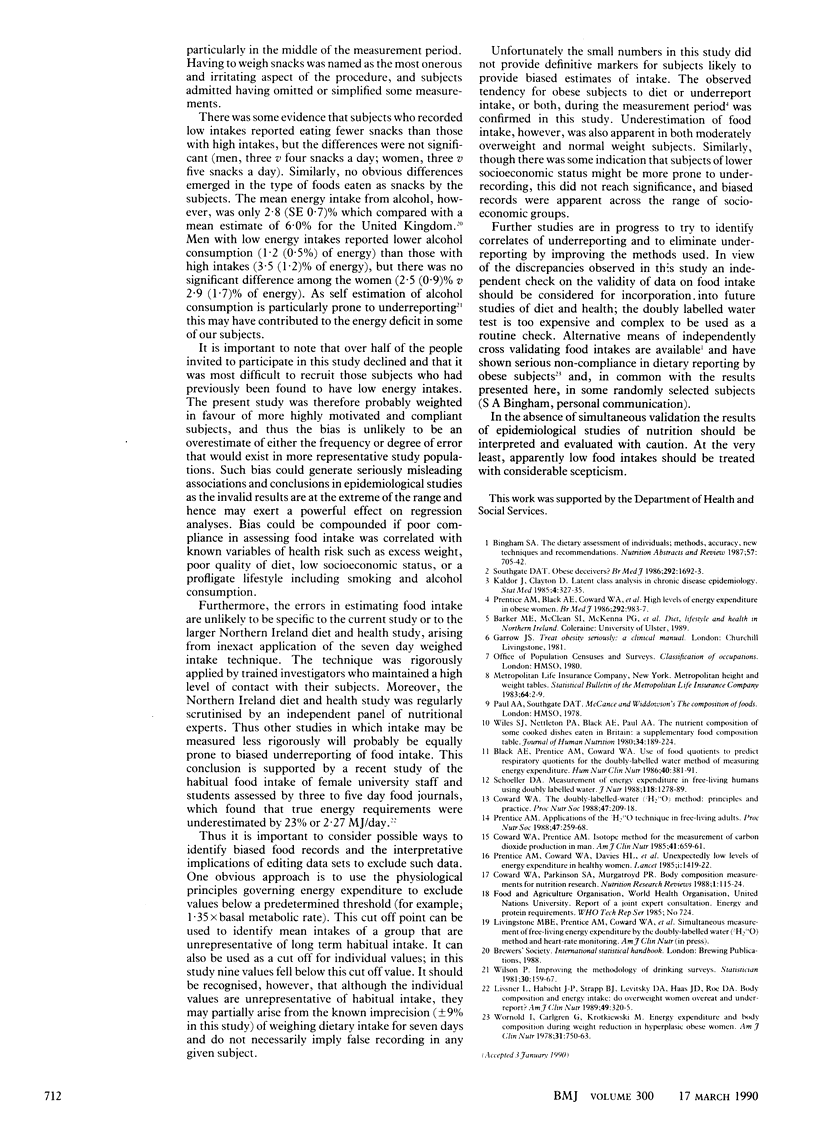Abstract
OBJECTIVE--To provide an independent evaluation of seven day weighed dietary records, which are currently accepted as the most accurate technique for assessing habitual dietary intake in studies investigating the links between diet and health. DESIGN--Subjects who had previously participated in the Northern Ireland diet and health study were reselected by stratified random sampling to represent the range of energy intakes in the study as assessed by the seven day weighed dietary record. SETTING--Northern Ireland. SUBJECTS--31 Free living adults (16 men and 15 women). MAIN OUTCOME MEASURES--Energy intake as measured by the seven day weighed dietary record and total energy expenditure estimated concurrently by the doubly labelled water technique. RESULTS--Average recorded energy intakes were significantly lower than measured expenditure in the group overall (9.66 MJ/day v 12.15 MJ/day, 95% confidence interval 1.45 to 3.53 MJ/day). Among those in the upper third of energy intakes the mean (SE) ratio of intake to expenditure was close to 1.0, indicating accurate records (men 1.01 (0.11), women 0.96 (0.08]. In the middle and lower thirds the ratios for men were only 0.74 (0.05) and 0.70 (0.07) respectively and for women 0.89 (0.07) and 0.61 (0.07). CONCLUSIONS--These results show a serious bias in reporting habitual energy intake. If substantiated they may have wide implications for the interpretation of many nutritional studies.
Full text
PDF




Selected References
These references are in PubMed. This may not be the complete list of references from this article.
- Black A. E., Prentice A. M., Coward W. A. Use of food quotients to predict respiratory quotients for the doubly-labelled water method of measuring energy expenditure. Hum Nutr Clin Nutr. 1986 Sep;40(5):381–391. [PubMed] [Google Scholar]
- Coward W. A., Prentice A. M. Isotope method for the measurement of carbon dioxide production rate in man. Am J Clin Nutr. 1985 Mar;41(3):659–663. doi: 10.1093/ajcn/41.3.659. [DOI] [PubMed] [Google Scholar]
- Coward W. A. Stable isotopic methods for measuring energy expenditure. The doubly-labelled-water (2H2(18)O) method: principles and practice. Proc Nutr Soc. 1988 Sep;47(3):209–218. doi: 10.1079/pns19880037. [DOI] [PubMed] [Google Scholar]
- Kaldor J., Clayton D. Latent class analysis in chronic disease epidemiology. Stat Med. 1985 Jul-Sep;4(3):327–335. doi: 10.1002/sim.4780040312. [DOI] [PubMed] [Google Scholar]
- Lissner L., Habicht J. P., Strupp B. J., Levitsky D. A., Haas J. D., Roe D. A. Body composition and energy intake: do overweight women overeat and underreport? Am J Clin Nutr. 1989 Feb;49(2):320–325. doi: 10.1093/ajcn/49.2.320. [DOI] [PubMed] [Google Scholar]
- Prentice A. M., Black A. E., Coward W. A., Davies H. L., Goldberg G. R., Murgatroyd P. R., Ashford J., Sawyer M., Whitehead R. G. High levels of energy expenditure in obese women. Br Med J (Clin Res Ed) 1986 Apr 12;292(6526):983–987. doi: 10.1136/bmj.292.6526.983. [DOI] [PMC free article] [PubMed] [Google Scholar]
- Prentice A. M., Coward W. A., Davies H. L., Murgatroyd P. R., Black A. E., Goldberg G. R., Ashford J., Sawyer M., Whitehead R. G. Unexpectedly low levels of energy expenditure in healthy women. Lancet. 1985 Jun 22;1(8443):1419–1422. doi: 10.1016/s0140-6736(85)91846-x. [DOI] [PubMed] [Google Scholar]
- Prentice A. M. Stable isotopic methods for measuring energy expenditure. Applications of the doubly-labelled-water (2H2(18)O) method in free-living adults. Proc Nutr Soc. 1988 Sep;47(3):259–268. doi: 10.1079/pns19880043. [DOI] [PubMed] [Google Scholar]
- Schoeller D. A. Measurement of energy expenditure in free-living humans by using doubly labeled water. J Nutr. 1988 Nov;118(11):1278–1289. doi: 10.1093/jn/118.11.1278. [DOI] [PubMed] [Google Scholar]
- Southgate D. A. Obese deceivers? Br Med J (Clin Res Ed) 1986 Jun 28;292(6537):1692–1693. doi: 10.1136/bmj.292.6537.1692. [DOI] [PMC free article] [PubMed] [Google Scholar]
- Warnold I., Carlgren G., Krotkiewski M. Energy expenditure and body composition during weight reduction in hyperplastic obese women. Am J Clin Nutr. 1978 May;31(5):750–763. doi: 10.1093/ajcn/31.5.750. [DOI] [PubMed] [Google Scholar]
- Wiles S. J., Nettleton P. A., Black A. E., Paul A. A. The nutrient composition of some cooked dishes eaten in Britain: a supplementary food composition table. J Hum Nutr. 1980 Jun;34(3):189–223. doi: 10.3109/09637488009143440. [DOI] [PubMed] [Google Scholar]


